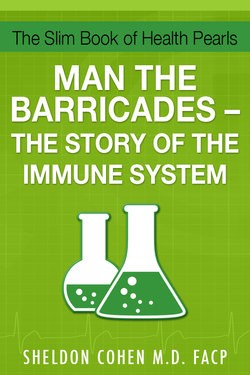Читать книгу The Slim Book of Health Pearls: Man the Barricades - The Story of the Immune System - Sheldon Cohen M.D. FACP - Страница 3
ОглавлениеThis is a short story about the body’s defenses against attack by enemies constantly trying to harm us. The principal actors are organs, cells, and complicated collections of proteins, tuned by billions of years of evolution to work in a harmonious manner for the good of the whole.
This short story will describe the various lines of defense used to keep us alive in a world where, on a daily basis, invisible or visible predators want to usurp our bodies. These predators are bacteria, fungi, pollen, viruses, parasites, cancer cells, and transplanted organs.
In the face of this onslaught, we owe a state of good health to our immune system: the collaborative mechanism that protects us from disease by utilizing a sophisticated team of specialized organs and cells that differentiate self from non-self. This ability is due to the fact that every body cell carries distinctive molecules (epitopes) on their surfaces that identify it as self. Immune cells, recognizing this self-marker, coexist peacefully in a state known as self-tolerance.
On the other hand, altered or foreign cells or organisms that do not carry this self-marker will find themselves subjected to an all out vigorous assault by the immune system.
Of course, transplanted organs can be life saving. Therefore, a careful physician must try to suppress the immune mechanism to a degree ensuring that the transplanted organ will continue to perform its function for the good of its new host. Failure to suppress the immune function enough will allow the host to overcome the transplanted organ in a process called rejection.
A substance capable of triggering an immune response is an antigen. These non-self invaders carry epitopes on their surfaces that immune cells immediately recognize as foreign, attack and neutralize or kill.
Immunology, the study of the immune system, has become a topic of interest since the advent of the autoimmune deficiency syndrome (AIDS). This epidemic has focused our attention on the consequences of a malfunctioning immune system. They include the assault on our bodies by opportunistic infections and malignant diseases. In addition severe combined immunodeficiency disease (SCID) is a thankfully rare condition present at birth that is characterized by a severe defect in T & B lymphocytes, our main immune cells (more later). This defect impairs the immune response and results in serious life threatening infections within the first few months of life.
The last sixty years have seen incredible advances in our study of immunity or resistance to disease. The underlying structure known as the lymphatic system is an efficient anatomical masterpiece working in the background, and without it our hearts would cease to beat and our immune system would become inoperable.
The lymphatic system includes a specialized body transport mechanism that delivers unique cells, fluid, proteins, and chemicals to any location invaded by predators, or altered non-self cells. Included in the lymphatic system are very specialized organs within which the lymphatic cells are manufactured and stored.
These structures are all involved in a well-coordinated surveillance and attack against bacteria, viruses, fungi, parasites, cancer cells, and transplanted organs. Even invaders such as dust particles, pollen, molds, and grasses are subject to immune assault. The job of this harmonious system is to identify, isolate, and destroy any foreign invader or anything that the system does not identify as belonging to it.
As amazing as this system is, it occasionally overreacts to allergens---substances that causes an allergy. Said another way, an allergen is any substance that causes the immune system to create an allergic reaction.
Worse yet is the overreaction that occurs when the system turns on its host body resulting in a myriad of autoimmune diseases. An autoimmune disease occurs when the immune system mistakes normal self-cells as non-self, attacks and inhibits their function or kills them outright. Some examples are rheumatoid arthritis, lupus erythematosis and multiple sclerosis.
The body has evolved superb nonspecific defense mechanisms against disease. Non-specific refers to those mechanisms, not programmed to zero in on specific enemies, but rather form defenses against them all.
These non-specific defense mechanisms known as innate immunity are present at birth, are not required to have a previous encounter with the invading or offending substance, and do not develop memory. The development of memory by a cell allows those cells prompt recognition of an antigen in the future.
